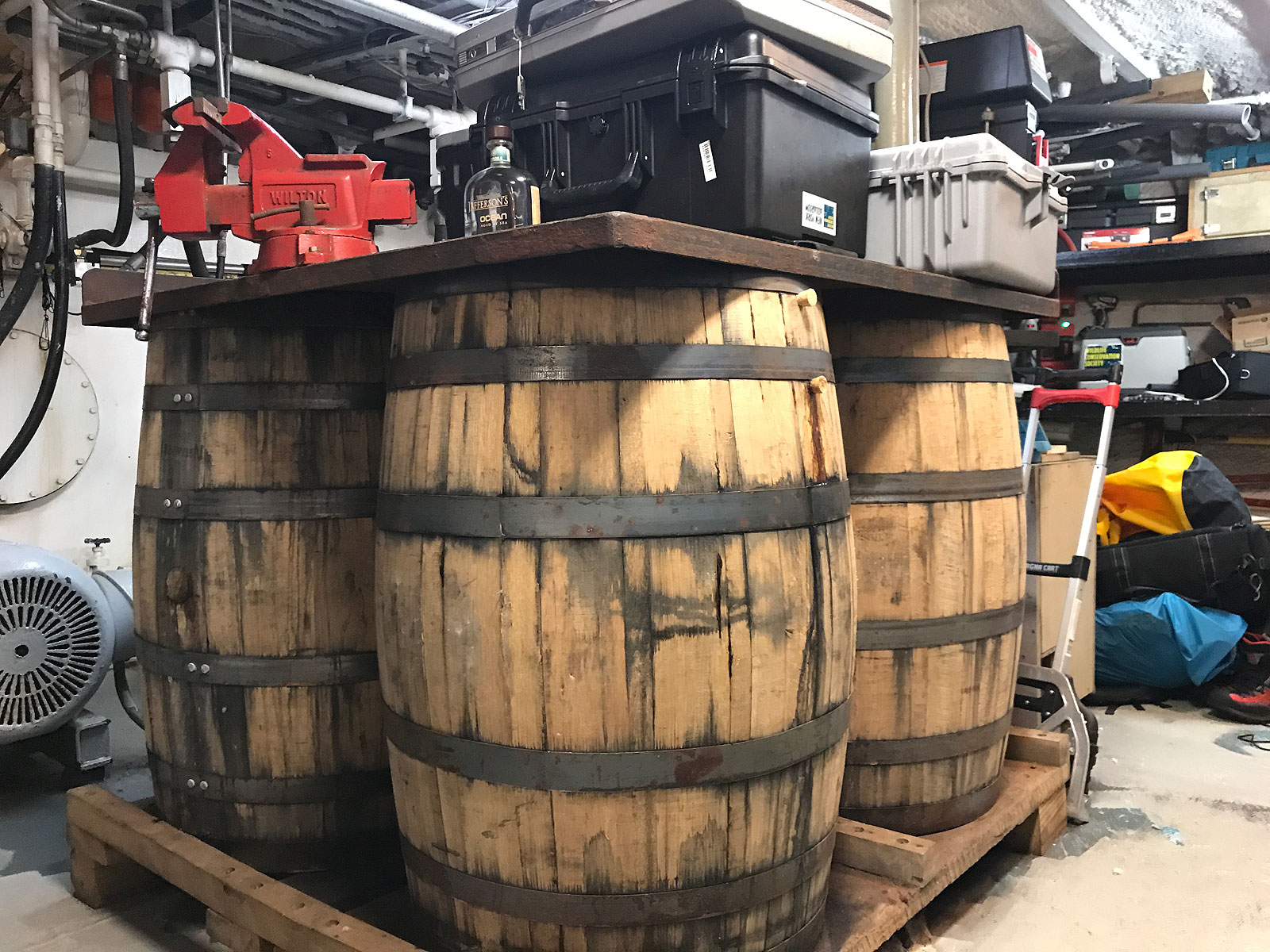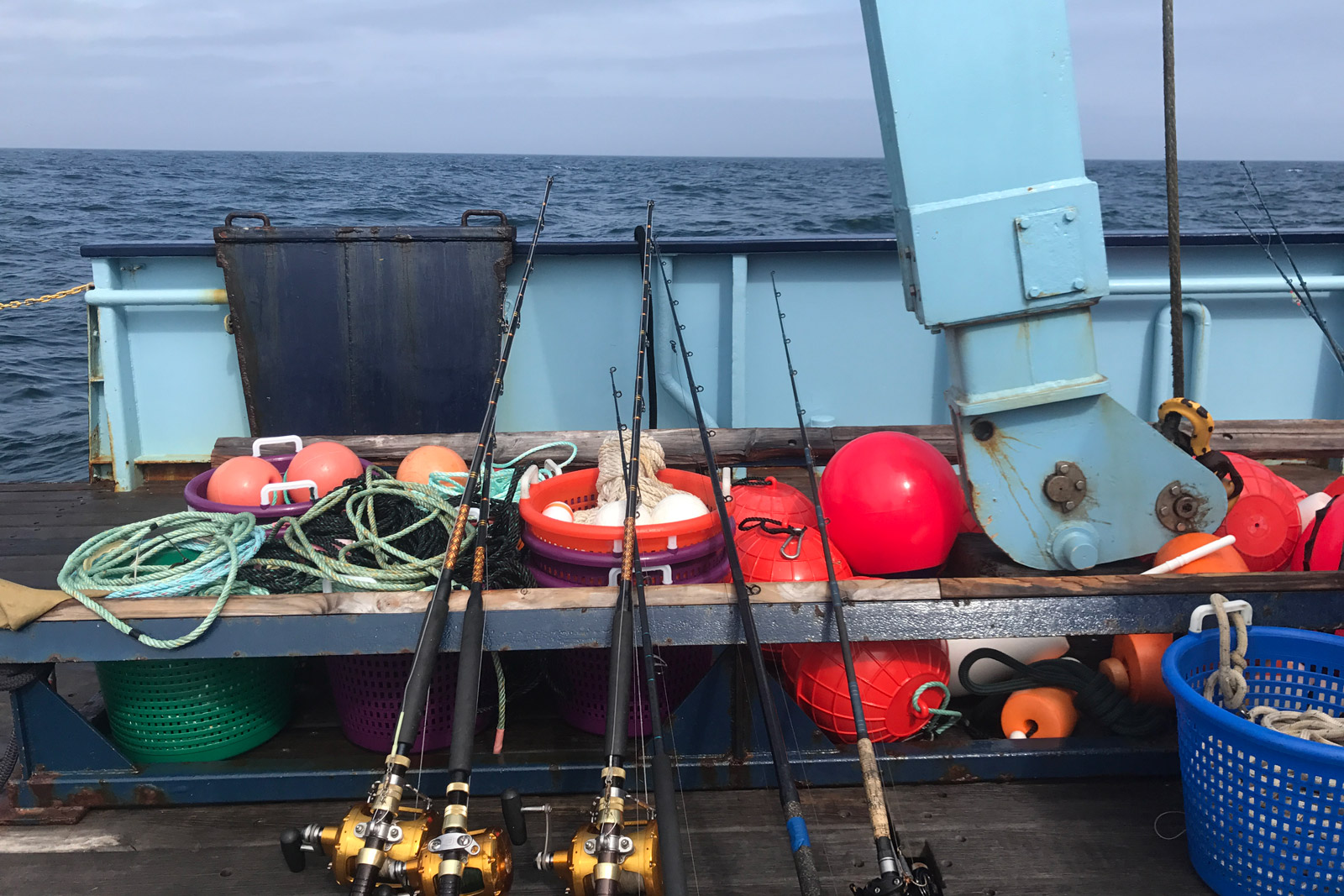Aboard the Ocearch with Jefferson’s Bourbon
Shark research and an aged-at-sea Ocean expression whiskey tasting off the coast of Montauk

Anchored just off the coast of Montauk’s beautiful beaches, the Ocearch swayed on gentle seas as we boarded from a smaller transport boat. The word “Ocearch,” which is the result of splicing together ocean and research, represents more than one thing. First, it’s the ship itself which houses 20+ crew members when on an expedition. Second, it’s a scientific non-profit dedicated to collecting information on great white sharks. And finally, it’s the crux of several television shows—including “Shark Wranglers,” for which it was more or less a character itself. Those traveling on the Ocearch find, catch, tag, document and release great white sharks. That data collected gets used in many different ways by many different organizations. When we stepped on board, it was to learn more about all this, but also to find out why such a vessel was toting around four full barrels of Jefferson’s Bourbon—a premium, small batch whiskey brand comprised of 16 different expressions including Ocean, Aged at Sea. Jefferson’s has long partnered with the Ocearch and the reason stretches back to the childhood of two present day pioneers.

Chris Fischer and Trey Zoeller have been friends since their youth in Kentucky. A decade ago, during Zoeller’s 40th birthday, an opportunity for partnership arose. “We were down in Costa Rica, having a great time fishing and surfing,” Zoeller explains to CH. “We saw the bourbon in our glasses sloshing around, back and forth, while we were on a boat. I thought, ‘What if we were to age our bourbon on Chris’ boat. It just came together.” Fischer adds, “I saw an opportunity to bring our universes together. It’s fun to have the barrels here, especially being a Kentucky boy, moving around the world turning people on to the idea of bourbon.”
Shortly thereafter, Zoeller brought three barrels to Fischer’s ship, which was then called the Ocean. They were kept on the bow and attacked by the elements. When Zoeller tapped the product, it was thick and luscious. He knew exactly what to do with it. “When I saw it was successful, I knew we had to continue to do it. I said, ‘Let’s keep barrels on your ship and donate those to your organization.'” This aligns with the mission of Fischer and Ocearch. “We are always looking for organizations that want to make business and do good at all times. We have an inclusive visions. Anyone who has that ocean-first, grandchildren-first disposition and wants to build something around that can be involved.”

He continues that their work is about delivering information to fill the “fundamental data gap required to move mankind and the ocean toward abundance.” That said, “This is also about proving the model that you can build enterprise in the world of connectivity that drives scale, engagement and influence—ultimately yielding value for socially innovative companies. Therefore, getting them to fund the exploration for science that we need.” The Ocearch does not rely on grants. It works with private companies who simply want to be involved.
We will win, we are doing something real for the future of the planet
Fischer explains, “I’m not into the doom and gloom non-profit story that keeps money flowing. We’re about being data-driven, science-based and pursuing practical paths so that we can move and create a trajectory. We will win. We are doing something real for the future of the planet.” Up to 18 institutions use the data they collect, as they seek to solve puzzles around this energetic apex predator. The data often gets turned into peer-reviewed papers. And the ultimate goal is to change policy.

Jefferson’s happens to be one of those companies allowing the Ocearch to thrive. Zoeller is undeniably an adventurer himself. He frequently notes the lack of innovation in the bourbon industry. Of his 16 expressions, 14 are highly experimental. For Ocean, he’s actually looking well into the past. The act of aging bourbon intentionally stemmed from the fact that whiskey that had been shipped in wood barrels tasted better than “white dog” spirit right off the tap. In addition to Ocean, he tested this theory with a remarkable product called Jefferson’s Journey—which floated down the Mississippi from Louisville to New Orleans, then rounded out to Key West and up to New York, the old shipping path. “Aging on the water really transformed the industry,” Zoeller explains. With Journey, he learned more than expected, as he needed to shift across four ships having fought a tropical storm and two hurricanes along the way. But the liquid turned out as tasty as expected.

For Ocean, Zoeller begins with an eight-year-old mature bourbon. On shelves now, one is most likely to find batch 11. For most batches, 11 included, the bourbon has spent seven to eight months visiting five continents and over 30 ports in new charred white american oak barrels. The product goes all the way up to the North Atlantic and crosses the equator four times. Zoeller has access to daily temperature reports and sea conditions—he also found a ship that touches ports that he felt would impart nuance to the liquid. This might not seem like a long time but its impact can be felt with a sip.
Zoeller points out that the Charleston Brown Water Society describes the final spirit best: it tastes like a salted caramel popcorn bourbon. We agree. There’s brininess, a butterscotch-like cream, a buttery mouthfeel atop its wheat origins and, of course, that signature bourbon potency (bottled at 90 proof). From the physical, documented act of condensing because of all the sloshing and evaporation to the impact on the barrel and the oxygen passing through, these months truly lend the bourbon a flavor drinkers will not find anywhere else. Not only is it good. It’s a bourbon most will benefit from having in their home bar, for both the quality of the product and the story behind it.

“Natural selection rewards efficiency,” Fischer adds as we begin to move the Ocearch down to Southampton. “If the tide is running, sharks are more likely to hunker down underneath it, on the bottom. Things in the ocean are not random. You have breakfast time, lunch time and dinner. They will feed when it is most advantageous to them. It’s all connected.” From a man at sea who grew chasing fish and frogs in the waters of Kentucky before falling in love with the ocean, it’s valuable advice. While he’s in search of scientific fact, his old friend is tinkering with exposure to the elements and what that all means on our tongue.
First four images by David Graver, all other images courtesy of Jefferson’s Bourbon












